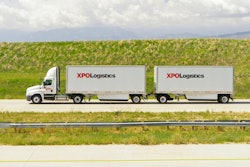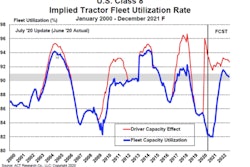I’ve been spending a bit of time lately thinking about ways to calculate freight efficiency and happen to be working on some projects with lots of number crunching. The term freight efficiency itself is not one that I have used much until the past few years, even though it’s in the name of the organization I work for: The North American Council for Freight Efficiency (NACFE).
Even among us NACFE folks, when we speak of freight efficiency we often are talking about a truck’s MPG, and I think there are a few reasons for that. It’s familiar and it makes sense when talking about efficiency at the truck level.
Of course, context matters.
When comparing different forms of transportation, such as rail and trucks, a variation on MPG called freight-ton efficiency (FTE) – also referred to as ton-miles per gallon – is often used. FTE is simply MPG multiplied by the weight of the payload in tons. While it can be useful when comparing transportation networks that have vastly different capacities, it sometimes gets used within trucking as well. During NACFE’s Run on Less events, and when we accompanied the Shell Starship, MPG and FTE were both talked about as a way to put the truck’s MPG in context to the weight of the payload.
While FTE has its uses, I will come right out and say that I’m often not a huge fan of it when thinking about the efficiency of trucks for a few reasons. For one, I believe it’s often mis-applied. It doesn’t work when the goods being hauled are different. That was evident in our Run on Less 2017. The truck hauling snacks for Frito-Lay happened to have a pretty similar MPG as another one transporting frozen foods, but their FTE was different by a multiple of more than three.
What does the higher FTE truck tell me? Not much except that a heavier truck gets higher FTE even with similar MPG. When thinking about large systems moving similar goods, FTE works well. At a truck level, it doesn’t tell us much.
The other big reason I’m not a fan of FTE is that it’s often not actionable for the shipper or fleet. Consider my previous example. I can improve the FTE of the snack hauling truck by loading heavier snacks or using heavier packaging. All that would result in snacks being transported to the same location with a higher FTE but not with higher efficiency. In actuality, it would lower efficiency since the MPG would go down with the increased weight.
Fortunately, shippers or fleets probably don’t make decisions based on FTE. If the shipper has multiple transport options for the same product, they would most likely consider some balance of cost (which indirectly includes efficiency), speed, reliability and more often these days, the carbon footprint. On the other hand, someone thinking about it at the truck level is best served with MPG.
Where FTE in trucking can be useful is when thinking about a larger transportation network. For example, something FTE captures that MPG doesn’t is empty miles. A truck gets its best MPG when empty, but its FTE is zero (since the payload is zero).
From a freight efficiency standpoint, a system with very high MPG trucks running empty half of the time is much worse than average MPG trucks that are loaded much of the time. In this case, maximizing MPG can steer you in the wrong direction and FTE would work better.
As freight transportation gets more varied, our industry is looking for more and different ways to measure efficiency. No single measurement is likely to work for all. FTE absolutely has its place but, like other measures, it can be used incorrectly. I would argue that at the truck level, FTE is usually not the right tool.
Yunsu Park is the Director of Engineering for NACFE and an independent consultant in the trucking industry. He has authored several Confidence Reports for NACFE in addition to the summary report for 2017 Run on Less. Park’s area of interest is in data collection and analysis, and technology implementation, particularly as it relates to human behavior. Prior to NACFE, Park was CTO for a technology start-up working with fleets on driver behavior and incentives and held various roles in finance and engineering at Navistar.











